A seismic shift is underway in the landscape of elite women`s football. The UEFA Women`s Champions League (UWCL), a competition synonymous with thrilling athleticism and strategic brilliance, is poised for a revolutionary transformation. As the 2025-26 season approaches, fans and strategists alike are buzzing about the introduction of the “Swiss model” – a format promising unprecedented depth, more high-stakes matches, and a truly global spectacle. At the heart of this new era lies an intricate draw, set to define the initial challenges for Europe`s finest.
A Bold New Chapter: Unpacking the “Swiss Model”
Gone are the traditional group stages, a format that, while familiar, sometimes lacked the sustained intensity demanded by top-tier competition. The UWCL now embraces an 18-team league phase, drawing inspiration from its men`s counterpart. This isn`t merely an expansion; it`s a complete re-imagining of the tournament`s foundation.
Under the new structure, all 18 clubs will compete in a single league table. Each team will navigate a rigorous schedule of six matches against six different opponents, with an equal split of three home and three away fixtures. This design ensures diverse matchups, forcing teams to adapt to varying playstyles and travel demands from the outset. The beauty of this model lies in its ability to reward consistent performance over the entire phase, making every pass, every tackle, and every goal potentially decisive.
The Path to Glory: New Progression Dynamics
The stakes have been significantly raised:
- Direct Quarter-Finalists: The top four teams in the single league table earn a coveted direct passage to the quarter-finals, bypassing an additional, potentially perilous, knockout stage.
- Knockout Play-offs: Teams finishing between fifth and twelfth place will engage in a tense, two-legged knockout play-off. This additional hurdle ensures that even teams outside the immediate top tier have a fighting chance to advance, adding layers of drama and unpredictability.
- Elimination: For those ranked 13th through 18th, the journey concludes after the league phase. A harsh reality, perhaps, but one that underscores the intense competition inherent in the new format.
The Architects of Fate: The Inaugural Draw in Nyon
The foundational step in this grand new design is the draw itself, scheduled to unfold in Nyon, Switzerland, this Friday, September 19th, at 6 a.m. ET. For those eager to witness history in the making, the event will be live-streamed on CBS Sports Golazo Network, ensuring fans don`t miss a single crucial pairing.
How the Draw Unfolds: A Blend of Tradition and Technology
The process is a meticulously crafted affair, combining the tangible drama of physically drawn balls with the precision of automated software. The 18 participating clubs are stratified into three pots of six, a division determined by their club coefficient rankings at the season`s inception. Reigning champions Arsenal, for instance, naturally secure a top-seed spot in Pot 1 – a subtle acknowledgment of their hard-earned supremacy.
Three distinct bowls will hold the team names, one for each pot. Each club will then be drawn against two opponents from each of the three pots, ensuring a balanced distribution of challenges. A key regulatory nuance: clubs from the same national association cannot be drawn against each other in this initial phase. However, teams may still face up to two opponents from any single other association, setting the stage for intriguing international matchups.
The Elite Ensemble: Teams Ready for the Challenge
The stage is set for a magnificent confluence of established giants and formidable challengers. Nine teams have already secured their berths directly, their reputations preceding them:
- Arsenal (England, titleholders)
- Lyon (France)
- Paris Saint-Germain (France)
- Bayern Munich (Germany)
- Wolfsburg (Germany)
- Barcelona (Spain)
- Chelsea (England)
- Benfica (Portugal)
- Juventus (Italy)
Joining these titans are nine teams who have bravely navigated the intense qualifying rounds, showcasing their mettle and ambition:
- Paris FC (France)
- Real Madrid (Spain)
- Atlético de Madrid (Spain)
- Manchester United (England)
- Roma (Italy)
- Twente (Netherlands)
- Vålerenga (Norway)
- St. Polten (Austria)
- OH Leuven (Belgium)
This diverse roster promises a league phase brimming with tactical battles, unexpected upsets, and fierce rivalries.
The Road Map: Key Dates for the 2025-26 UWCL
The journey through this revamped tournament is a long and arduous one, designed to test the endurance and skill of every team. Here’s a brief overview of the critical junctures:
| Phase | Dates |
|---|---|
| League Phase |
Matchday 1: Oct. 7-8 Matchday 2: Oct. 15-16 Matchday 3: Nov. 11-12 Matchday 4: Nov. 19-20 Matchday 5: Dec. 9-10 Matchday 6: Dec. 17 |
| Knockout Phase Play-offs |
Draw: Dec. 18 (Nyon, Switzerland) First leg: Feb. 11-12 Second leg: Feb. 18-19 |
| Quarter-finals |
Draw: Dec. 18 (Nyon, Switzerland) First leg: March 24-25 Second leg: April 1-2 |
| Semi-finals |
Draw: Dec. 18 (Nyon, Switzerland) First leg: April 25-26 Second leg: May 2-3 |
| Champions League Final | May 22-24 (Ullevaal Stadion, Oslo, Norway) |
The 2025-26 UEFA Women`s Champions League is not just another season; it`s a testament to the growth and ambition of women`s football. With its groundbreaking “Swiss model,” expanded league phase, and complex knockout stages, the tournament promises to be a captivating saga of skill, strategy, and sheer determination. As the draw commences, the first seeds of this new era will be sown, setting the stage for what is sure to be an unforgettable journey towards European glory. Prepare for a season where every match matters, and the path to becoming champion demands nothing short of perfection.





